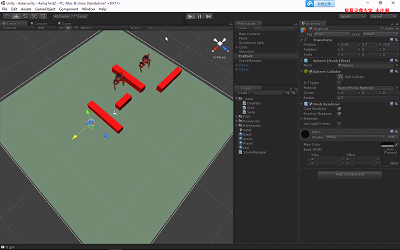A star 寻路
大白话说一下几个点:
通俗的来说,其实就是以一个规则来 从A点走到B点。
怎么来判断我们走的格子是一个合适的格子?
就是靠一个规则来计算,这个规则就是估价函数。
估价函数:
常用:曼哈顿算法
F = G + H
G:表示从起点 A 移动到网格上指定方格的移动耗费 (可沿斜方向移动).
H:表示从指定的方格移动到终点 B 的预计耗费
G值的计算:
假定:左右上下方向的移动产生的耗费是10
那么在斜方向的移动耗费 就是 左右上下方向耗费的 根号2 倍,就是14咯
H值的计算:
(H 有很多计算方法, 这里我们设定只可以上下左右移动).
就是算是指定格子 到 终点格子的 横方向上的耗费+竖方向上的耗费。
开启列表:就是一个等待检查方格的列表.
关闭列表:存放不需要再次检查的方格的列表
伪代码:
把起始格添加到 “开启列表”
do
{
寻找开启列表中F值最低的格子, 我们称它为当前格.
把它切换到关闭列表.
对当前格相邻的8格中的每一个
if (它不可通过 || 已经在 “关闭列表” 中)
{
什么也不做.
}
if (它不在开启列表中)
{
把它添加进 “开启列表”, 把当前格作为这一格的父节点, 计算这一格的 FGH
}
if (它已经在开启列表中)
{
if (用G值为参考检查新的路径是否更好, 更低的G值意味着更好的路径)
{
把这一格的父节点改成当前格, 并且重新计算这一格的 GF 值.
}
}
} while( 目标格已经在 “开启列表”, 这时候路径被找到)
如果开启列表已经空了, 说明路径不存在.
最后从终点开始, 沿着每一格的父节点移动直到回到起始格, 这就是路径。

地图信息:
1,不可走
0,可走

在Unity里效果如下:

节点:
using UnityEngine; using System.Collections; public class Node { public bool canWalk;//是否可以行走 public Vector3 worldPos;//节点的位置 public int gridX, gridY;//地形网格的下标 public int gCost;//离起始点的耗费 public int hCost;//离目标点的耗费 public int fCost { get { return gCost + hCost; } } public Node parent;//父对象 public Node(bool _canWalk, Vector3 _pos, int _x, int _y) { canWalk = _canWalk; worldPos = _pos; gridX = _x; gridY = _y; } }
地图网格:
using UnityEngine; using System.Collections; using System.Collections.Generic; public class Grid : MonoBehaviour { public Node[,] grid;//网格,是Node节点的二维数组 public Vector2 gridSize;//网格的大小 public float nodeRadius;//节点的半径 private float nodeDiameter;//节点的直径 public LayerMask whatLayer;//是可走层还是不可走层 public int gridCountX, gridCountY;//每一行、列有几个Node public List<List<Node>> AllPath = new List<List<Node>>();//所有人的路径 void Start() { nodeDiameter = nodeRadius * 2; gridCountX = Mathf.RoundToInt(gridSize.x / nodeDiameter); gridCountY = Mathf.RoundToInt(gridSize.y / nodeDiameter); grid = new Node[gridCountX, gridCountY]; CreateGrid(); } void CreateGrid() { //左下角 Vector3 startPoint = this.transform.position - gridSize.x / 2 * Vector3.right - gridSize.y / 2 * Vector3.forward; for (int i = 0; i < gridCountX; i++) { for (int j = 0; j < gridCountY; j++) { Vector3 worldPoint = startPoint + Vector3.right * (i * nodeDiameter + nodeRadius) + Vector3.forward * (j * nodeDiameter + nodeRadius); bool walkable = !Physics.CheckSphere(worldPoint, nodeRadius *2, whatLayer);//检测半径(直径)范围内是否可行走,发射球形射线检测层 grid[i, j] = new Node(walkable, worldPoint, i, j); } } } void OnDrawGizmos() { //画地形网格边缘 Gizmos.DrawWireCube(transform.position, new Vector3(gridSize.x, 1, gridSize.y)); //画节点Node if (grid == null) return; foreach (var node in grid) { Gizmos.color = node.canWalk ? Color.white : Color.red; Gizmos.DrawCube(node.worldPos, Vector3.one * (nodeDiameter - .1f)); } //画角色 /* Node playerNode = GetFromPositon(player.position); if (playerNode != null && playerNode.canWalk) { Gizmos.color = Color.yellow; Gizmos.DrawCube(playerNode.worldPos, Vector3.one * (nodeDiameter - .1f)); }*/ //画路径 //if (path != null) //{ // foreach (var node in path) // { // Gizmos.color = Color.black; // Gizmos.DrawCube(node.worldPos, Vector3.one * (nodeDiameter - .1f)); // } //} if (AllPath.Count > 0) { for (int i = 0; i < AllPath.Count; i++) { if (AllPath[i].Count > 0) { foreach (var node in AllPath[i]) { Gizmos.color = Color.black; Gizmos.DrawCube(node.worldPos, Vector3.one * (nodeDiameter - .1f)); } } } } } }
寻路:
using UnityEngine; using System.Collections; using System.Collections.Generic; public class FindPath { public Grid mapGrid; private GameObject npc, target; private List<Node> FinalPath = new List<Node>(); public List<Node> GetFinalPath(GameObject self, GameObject target) { FindingPath(self.transform.position, target.transform.position); return FinalPath; } public void FindingPath(Vector3 _startPos, Vector3 _endPos) { //Node startNode = mapGrid.GetFromPositon(_startPos); //Node endNode = mapGrid.GetFromPositon(_endPos); Node startNode = GetFromPositon(_startPos); Node endNode = GetFromPositon(_endPos); //开启列表 List<Node> openSet = new List<Node>(); //关闭列表 HashSet<Node> closeSet = new HashSet<Node>(); openSet.Add(startNode); while (openSet.Count > 0) { Node currentNode = openSet[0]; for (int i = 0; i < openSet.Count; i++) { if (openSet[i].fCost < currentNode.fCost && openSet[i].hCost < currentNode.hCost) { currentNode = openSet[i]; } } openSet.Remove(currentNode); closeSet.Add(currentNode); if (currentNode == endNode) { GeneratePath(startNode,endNode); return; } foreach (var node in GetNeibourhood(currentNode)) { if (!node.canWalk || closeSet.Contains(node)) continue; int newCost = currentNode.gCost + GetNodesDistance(currentNode,node); if (newCost < node.gCost || !openSet.Contains(node)) { node.gCost = newCost; node.hCost = GetNodesDistance(node,endNode); node.parent = currentNode; if (!openSet.Contains(node)) { openSet.Add(node); } } } } } private void GeneratePath(Node startNode,Node endNode) { List<Node> path = new List<Node>(); Node temp = endNode; while (temp != startNode) { path.Add(temp); temp = temp.parent; } path.Reverse(); FinalPath = path; mapGrid.AllPath.Add(FinalPath); } public int GetNodesDistance(Node a, Node b) { int countX = Mathf.Abs(a.gridX - b.gridX); int countY = Mathf.Abs(a.gridY - b.gridY); if (countX > countY) { return 14 * countY + 10 * (countX - countY); } else { return 14 * countX + 10 * (countY - countX); } } //角色在哪个节点之上 public Node GetFromPositon(Vector3 _PlayerPos) { float percentX = (_PlayerPos.x + mapGrid.gridSize.x / 2) / mapGrid.gridSize.x; float percentY = (_PlayerPos.z + mapGrid.gridSize.y / 2) / mapGrid.gridSize.y; percentX = Mathf.Clamp01(percentX); percentY = Mathf.Clamp01(percentY); int x = Mathf.RoundToInt((mapGrid.gridCountX - 1) * percentX); int y = Mathf.RoundToInt((mapGrid.gridCountY - 1) * percentY); return mapGrid.grid[x, y]; } //获取节点周围的节点 public List<Node> GetNeibourhood(Node node) { List<Node> neribourhood = new List<Node>(); for (int i = -1; i <= 1; i++) { for (int j = -1; j <= 1; j++) { if (i == 0 && j == 0) { continue; } int tempX = node.gridX + i; int tempY = node.gridY + j; if (tempX > 0 && tempY > 0 && tempX < mapGrid.gridCountX && tempY < mapGrid.gridCountY) { neribourhood.Add(mapGrid.grid[tempX, tempY]); } } } return neribourhood; } }
还有许多优化的地方:
1.多单位寻路
2.动态障碍
- 本文固定链接: http://www.shihuanjue.com/?p=103
- 转载请注明: 乔 2015年09月26日 于 是幻觉 发表



